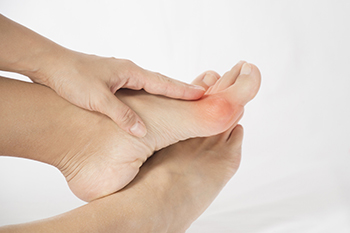
 A bunion is a bony bump that can form at the base of the big toe joint. Many people believe that bunions are a strictly cosmetic issue, only affecting the way that the foot looks, but bunions can also be painful and lead to other foot problems that may interfere with your day-to-day life. A bunion can push your big toe towards the smaller ones, changing the shape of the foot and making the big toe joint sore, stiff, swollen, or inflamed. Blisters, corns, and calluses may form in between or on top of the toes as your shoe rubs against the bunion. All of these symptoms can lead to difficulty walking and going about your daily activities. Furthermore, bunions can increase your risk of other potentially painful foot problems, including hammertoes, bursitis, and metatarsalgia. Bunions tend to worsen over time, so if you notice a bunion forming on your foot, it is suggested that you see a podiatrist for treatment as soon as possible.
A bunion is a bony bump that can form at the base of the big toe joint. Many people believe that bunions are a strictly cosmetic issue, only affecting the way that the foot looks, but bunions can also be painful and lead to other foot problems that may interfere with your day-to-day life. A bunion can push your big toe towards the smaller ones, changing the shape of the foot and making the big toe joint sore, stiff, swollen, or inflamed. Blisters, corns, and calluses may form in between or on top of the toes as your shoe rubs against the bunion. All of these symptoms can lead to difficulty walking and going about your daily activities. Furthermore, bunions can increase your risk of other potentially painful foot problems, including hammertoes, bursitis, and metatarsalgia. Bunions tend to worsen over time, so if you notice a bunion forming on your foot, it is suggested that you see a podiatrist for treatment as soon as possible.
If you are suffering from bunion pain, contact Dr. Thomas Tran of Southwestern Foot & Ankle Associates, P.C.. Our doctor can provide the care you need to keep you pain-free and on your feet.
What Is a Bunion?
Bunions are painful bony bumps that usually develop on the inside of the foot at the joint of the big toe. As the deformity increases over time, it may become painful to walk and wear shoes. Women are more likely to exacerbate existing bunions since they often wear tight, narrow shoes that shift their toes together. Bunion pain can be relieved by wearing wider shoes with enough room for the toes.
Causes
Symptoms
In order to diagnose your bunion, your podiatrist may ask about your medical history, symptoms, and general health. Your doctor might also order an x-ray to take a closer look at your feet. Nonsurgical treatment options include orthotics, padding, icing, changes in footwear, and medication. If nonsurgical treatments don’t alleviate your bunion pain, surgery may be necessary.
If you have any questions, please feel free to contact our office located in Frisco, TX . We offer the newest diagnostic and treatment technologies for all your foot care needs.
Copyright © Southwestern Foot and Ankle Associates, P.C. | Site Map | Nondiscimination | Design by: Podiatry Content Connection